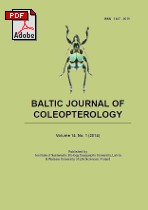The diversity and structure of ground beetles (Coleoptera: Carabidae) assemblages in differently managed winter wheat fields
Main Article Content
Keywords
:
Carabidae, soil tillage, pre-crop, dominance structure, biodiversity, Triticum aestivum, Latvia
Abstract
Ground beetles (Carabidae) are significant elements of integrated pest management (IPM) as they are natural enemies of pests and weeds in any agro-ecosystem. This research is part of a larger study on ground beetles as bio-indicators in IPM in Latvia. The objective of this research was to find out how traditional and minimal soil tillage and different pre-crops - spring rapeseed (Brassica napus), spring wheat (Triticum aestivum), and winter wheat - affect the dominance structure and biodiversity of ground beetles in winter wheat fields. The research was carried out at the Latvia University of Agriculture Research and Study Farm "Peterlauki" (56°30'39.38''N; 23°41'30.15''E) using 12 differently tilled and pre-cropped sample plots (0.3 ha) during 2012. Totally, 66 ground beetle species were recorded, eight of which - Loricera pilicornis, Bembidion guttula, Bembidion obtusum, Poecilus cupreus, Harpalus rufipes, Pterostichus melanarius, Pterostichus niger, and Amara plebeja - were dominants or subdominants in the sample plots with at least one type of management. The dominance structure of ground beetles was mostly affected by soil tillage, but biodiversity was affected by both agro-ecological factors simultaneously. In fields pre-cropped with spring rapeseed, the biodiversity of ground beetles positively correlated with intensiveness of soil tillage while, in fields pre-cropped with spring wheat, more intensive soil tillage led to lower biodiversity of ground beetles. In fields pre-cropped with winter wheat, biodiversity was not affected by soil tillage.
Article Details
Statistics
Downloads
Download data is not yet available.
Recommend Articles
